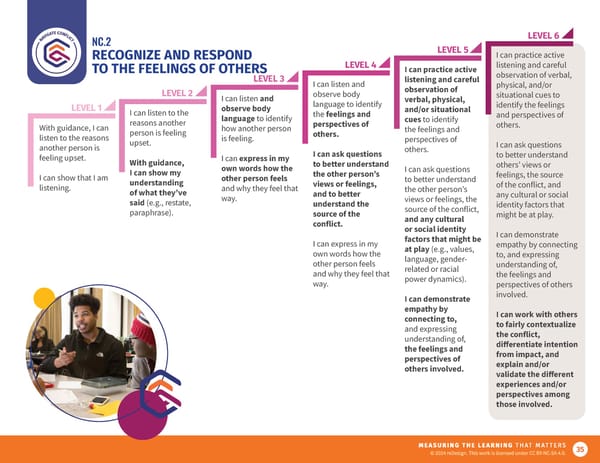NC.2 LEVEL 6 RECOGNIZE AND RESPOND LEVEL 5 I can practice active TO THE FEELINGS OF OTHERS LEVEL 4 I can practice active listening and careful LEVEL 3 listening and careful observation of verbal, LEVEL 2 I can listen and observation of physical, and/or I can listen and observe body verbal, physical, situational cues to LEVEL 1 observe body language to identify and/or situational identify the feelings I can listen to the language to identify the feelings and cues to identify and perspectives of With guidance, I can reasons another how another person perspectives of the feelings and others. listen to the reasons person is feeling is feeling. others. perspectives of another person is upset. others. I can ask questions feeling upset. I can express in my I can ask questions to better understand With guidance, own words how the to better understand I can ask questions others’ views or I can show that I am I can show my other person feels the other person’s to better understand feelings, the source listening. understanding and why they feel that views or feelings, the other person’s of the conflict, and of what they’ve way. and to better views or feelings, the any cultural or social said (e.g., restate, understand the source of the conflict, identity factors that paraphrase). source of the and any cultural might be at play. conflict. or social identity factors that might be I can demonstrate I can express in my at play (e.g., values, empathy by connecting own words how the language, gender- to, and expressing other person feels related or racial understanding of, and why they feel that power dynamics). the feelings and way. perspectives of others I can demonstrate involved. empathy by I can work with others connecting to, to fairly contextualize and expressing the conflict, understanding of, di昀昀erentiate intention the feelings and from impact, and perspectives of explain and/or others involved. validate the di昀昀erent experiences and/or perspectives among those involved. 35
 Future9 Framework Page 34 Page 36
Future9 Framework Page 34 Page 36